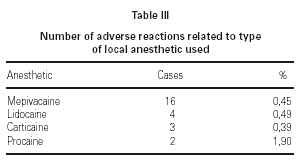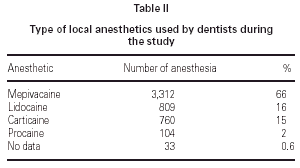INTRODUCTION
The local anesthetics (LA) are very often used drugs in odontology. Its use makes the dental therapy easier and allows reassurance of patient to whom some painful techniques will be applied.
Although LA are usually well-tolerated drugs, they can precipitate adverse reactions of different types and severity (1-3). These reactions can be directly related to the LA (allergic reaction/idiosyncratic) (4, 5) to their doses (toxic reaction or overdosage) (6); or to psychogenic/vasovagal factors such as fear and anxiety caused by the anesthetic/dental act.
Other substances associated with the LA (antioxidants, conservers, nor-epinephrine) (7, 8) can also produce adverse reactions or even allergic reactions (9).
True incidence of LA allergic reactions is unknown. In some papers they are considered as rare events and their incidence is established in less than 1 % of all the LA adverse reactions (2). Nevertheless, any adverse reaction appeared after an anesthetic act, during medical or dental therapies, are frequently primarily ascribed to an "allergic cause". This generally incites the patient, the dentist and the physician to fear and anguish. Therefore, people that have other types of adverse reactions are diagnosed as allergic, getting problems during the future therapeutic management. Sometimes, treatments that require LA injections are differed and chirurgical procedures are performed without anesthesia or in the contrary, patients are submitted to general anesthesia with the risks it implies.
Many papers in the literature, report LA allergic reactions related to isolated cases (10-16) or to groups of subjects with previous adverse reactions (17-21). There are no prospective studies publications that assess the real incidence of LA allergic or adverse reactions in dentistry. For that reason, a multidisciplinary group with dentists and allergists decided to study and to clarify these points.
The objectives of the present study were:
To estimate the immediate adverse events incidence in subjects who required an LA injection during a dentist therapy,
To assess the incidence of immediate allergic reactions among adverse events,
To relate allergic reactions with atopic antecedents.
MATERIAL AND METHODS
Study Sample Characteristics
A prospective, open-label, no controlled study with a sample of 5,018 patients, adults and children, that asked for dental therapy in 7 either private or public centers in Montevideo, Uruguay and who required injections with different types of LA, was performed.
The study lasted for three years (7/97-7/00).
Each dentist compiled data from every patient he had to inject with a LA. A previously designed form was filled. This form considered different aspects related to patients personal antecedents (allergy, previous adverse reactions to LA, etc.) as well as relationship between reactions and type of LA, and the characteristics of observed allergic or adverse reactions (table I).
The adverse events shown up during the first hour after the LA inoculation was assessed. Patients had to stay at the dentist office during that period, being watched by the dentist himself and by a technician.
Each patient was instructed to report to his dentist any delayed adverse reaction in order to meet an allergist.
The medical-odontological staff performed instructing meetings during the preceding months previous to the start of the study, in order to get acquainted of the subject and to be able to collectively design the data collection form and to apply the correct technique to make an accurate diagnosis of the adverse reactions.
Each time the dentist had diagnosis doubts or was in front of a verified adverse event, an appointment was made with an allergist to confirm the type of allergic reaction.
Clinic history, skin testing (prick and intra-dermal) and dose provocative challenge test with the probably causative LA following the Patterson et al. recommended technique (22) were used to establish the diagnosis of allergy. Patients, their parents or their legal representative were asked to sign an informed consent.
RESULTS
Study population characteristics
A total of 5018 patients entered the study. Age: (media = 25.4 years old, range 1-90 years old) Gender: females 52.8 % (n = 2,652) and males 47.2 % (n = 2,366).
Four different types of local anesthetics were used (mepivacaine, lidocaine, carticaine and procaine). All of them are currently used in our country as it is shown in table II.
Personal antecedents
Nine per cent of the population (n = 452) manifested some allergic illness (asthma, rhinitis, eczema, or insect sting anaphylaxis) and 0.4 % (n = 23) referred some previous adverse event after LA injection during dental treatments.
Adverse reactions
Twenty-five adverse reactions were found, representing 0.5 % of the study sample. Sixty-eight per cent of them occurred in women (n = 17) and 32 % in men (n = 8).
Twenty-four of the 25 patients who had adverse reactions, had previously received LA. Four of them (16.7 %) had a similar adverse reaction in that opportunity.
In five of the 25 patients a topic anesthetic was used previous to the LA injection.
Ninety-two per cent (n = 23) received LA associated with vasoconstrictors.
The infiltrative technique was used in 40 % of the cases, regional anesthesia was applied in 28 % of patients (n = 7) and 32 % (n = 8) received an infiltrative and regional anesthesia.
Adverse Reaction depending on the LA used
Although mepivacaine was the most used LA and that which had the greatest number of adverse reactions, the percentage of reactions is not higher than those presented with other types of anesthetics. The relationship between the LA used and the cases that presented adverse events are described in table III.
Types of averse reactions
Most of them (22/25) were mild, quickly and spontaneously (not requiring medication) reversed psychogenic or neurovegetative reactions, starting immediately, within 30 minutes after the anesthetic act (table IV).
One of the patients presented inflammation with pruritus and an itching sensation on the inferior dental nerve innervated face surface area, where the dentist made the regional type LA infiltration (carticaine). Those symptoms were related with local anesthetic technique complications.
Another case presented eyelids edema 8 hours after the LA injection (procaine) without others associated clinical manifestations. Clinical and skin tests as well as the dose provocative challenge test with the LA prove no allergic mechanism and the later administration of the LA by the dentist, was well tolerated. Other case, corresponding to a female patient of 18 years old, showed eyelid and peri-ocular edema, urticaria and pruritus on the abdominal surface and cough. The symptoms began 3 hours after the injection of 3 % mepivacaine associated with vasoconstrictors using the infiltrative technique. The patient visited an emergency doctor who diagnosed "allergy". She was treated with antihistamines and corticoids improving within 12 hours. She was then sent to an allergist to be studied.
According to the clinical history the patient had not received any previous medication before the anesthetic act. The dentist used latex gloves, cleaned the zone with acid grave and used methacrylate resins during the treatment.
The study performed by the allergist showed:
Total serum IgE level: 25 U/I.
Skin prick test (Hollister-Stier Laboratory) and latex RAST: negative.
Skin and dose provocative challenge tests were done with mepivacaine (without vasoconstrictors). They were well tolerated and it was possible to inject up to 3 cc of non-diluted LA (22). Later odontological treatment showed no complications.
DISCUSSION
There are two groups of LA with different chemical characteristics as well as different sensitization power:
Group I. Benzoic acid ester: benzocaine, clorprocaine, cocaine, piperocaine, procaine, propoxicaine, tetracaine. The para-aminobenzoic acid, one of its metabolic products, can produce hypersensitivity. These anesthetics have crossed-reaction between them. Their chemical composition is similar to other antigenic compounds with which they can have a crossed-reaction either. Most of the allergic reactions found in the literature on the past decades have been ascribed to these drugs, especially to procaine.
Group II. Amides: lidocaine, mepivacaine, carticaine, bupicaine, prilocaine, articaine. They have little sensitization power and have no crossed-reactions between them. They are the most frequently used, nowadays.
Our study gathered an important number of subjects who required injections of LA. A very low incidence of adverse reactions (0.5 %) was found. None of those reactions was caused by allergic mechanism. These findings support the opinion of other investigators who consider allergy to be a rare complication of LA (5, 17, 22-24).
Paterson et al. stated: "in more than 30 years of specialty practice in the Norwest of the United States, there has never been verified an immediate allergic reaction using our diagnostic methodology" (22) This low allergic incidence is probably related to the broad present use of LA belonging to the amide group that, as we just said, has a low sensitization power (25).
Two of the patients in our study had reactions initially diagnosed as "allergic" (patients 17 and 18). Nevertheless, the later allergist study discarded this etiology and allowed the patient to continue the dental therapy using the LA. The dentist and the physician often have to face such a situation. In some occasions there is no explanation for its etiology, while in others, the cause can be found in adverse reactions due to medication prescribed to treat the dental illness (antibiotics, non-steroid anti-inflammatory drugs) or substances used by the dentist during the treatment procedure (latex, resins, etc.) (26).
Some people feel dental treatment as a big stress. During its course the patient faces situations that can cause anguish or fear, as: the utilization of aggressive instruments (syringes, nippers), painful procedures to be applied in sensitized areas, bothering auditory stimuli (turbines, motors), offensive to taste or foul-smelling substances, maintaining uncomfortable positions during long periods, etc.
The dental illness that caused the appointment, the dentist procedure techniques and the psychic susceptibility of some patients, can generate a psychogenic o vasovagal reaction during treatment. Anxiety, deep breath, pallor, sweat, nausea, thrill, confusion, lost of consciousness are the symptoms present in such a situation. The patient can improve in minutes after being put in a supine position or in a Trendelemburg position.
Most of the adverse reactions found in our study (88 %) have been due to this cause. Four of those patients had had similar reactions during previous dental treatments as a manifestation of their psychic lability.
Our findings are similar to those of other authors who think that the psychic reactions are the most frequent adverse reactions that follow the LA injection (20, 27-29)
CONCLUSION
Our study results as well as others investigators opinion, orient us to the idea that the allergic reactions to LA are very rare and that most of the adverse events have a psychogenic cause. The physician and the dentist should know these facts, should be able to reassure their patients and to prepare them to minimize the frequent fears and "myths" that are built around the LA use.












